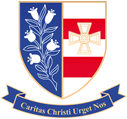Why Hairdressing & Beauty Therapy?
The study of NVQ Level 2/3 Hairdressing & Beauty Therapy is a complete course in itself and is designed for all students, whether or not they intend to take the subject further. Hair & Beauty is a constantly changing industry that shape and have an impact on our everyday lives. Students from St. Joseph’s have gone on to study Media make-up and advanced Hair & Beauty studies following their achievements with us, Jaz Training Ltd., at ‘Saints’ Hair & Beauty at St. Josephs.
The skills gained from NVQ Level 2/3 are transferable to other subjects as well as being needed for further study, the workplace and life generally. All we ask is that you have a keen and active interest and have the ability to work as part of a team.
Study Hair & Beauty – learn new practical skills and also communication/life skills!
Course Content
Level 2 Hairdressing/Beauty Therapy (Year 12):
The VTCT Level 2 NVQ Diploma in Hairdressing is a substantial vocational qualification for learners that are seeking a career as an employed or self-employed junior hairdresser/stylist. The course comprises theory and practical assessment observations. There are no end of year exams, each unit has an end of unit assessment paper. This qualification is based on the Level 2 Hairdressing & Beauty Therapy Occupational Standards (NOS) and is recognised by the UK’s lead hairdressing & beauty professional associations as being fit for preparing learners for a career as a junior stylist/therapist.
During this year you will get the opportunity to take part in a regional Hair & Beauty competition, if successful this will lead to the National finals that are held in Blackpool.
Level 3 Hairdressing/Beauty Therapy (Year 13):
The VTCT Level 3 NVQ Diploma in Hairdressing is an occupational qualification for learners seeking a career as an employed and/or self-employed hairdresser/stylist. This qualification is based on Hairdressing National Occupational Standards (NOS) and is recognised by the UK’s lead hairdressing professional association (The Hairdressing Council) as being fit for purpose for preparing learners for a career as a senior hairdresser/stylist. Learners should hold a Level 2 qualification in hairdressing prior to undertaking this qualification.
Careers/Higher Education Pathways
This qualification forms part of a suite of hairdressing qualifications. This qualification is of similar size to the VTCT Level 3 Diploma in Women’s Hairdressing. Whilst both qualifications qualify learners to become senior hairdressers/stylists, this qualification requires learners to work in a commercial hairdressing salon whereby assessments must be carried out on real paying clients in line with commercial service times. In contrast, the VTCT Level 3 Diploma in Women’s Hairdressing and VTCT Level 3 Diploma in Hairdressing Studies can be achieved through gathering evidence in a college’s realistic working environment without the necessity for real paying clients.
So, the VTCT Level 3 NVQ Diploma in Hairdressing is for learners seeking to work in, and develop their skills in a commercial setting, and can only be delivered by schools/colleges that have, or have access to a ‘real’ salon, and not a realistic working environment.
This qualification has been specifically designed for the 16-19 age group, builds on existing knowledge and understanding of hairdressing and will develop an enhanced repertoire of technical skills to prepare learners for employment as a senior hairdresser/stylist. Learners will work in, and have their hairdressing skills assessed in a ‘real’ commercial salon.
This qualification includes all the required elements to work effectively as an advanced hairdresser/stylist including: health and safety; client consultation; advanced cutting and; selling products and services to clients. These units are all mandatory.
Career progression routes as an advanced hairdresser/senior stylist exist in a variety of contexts, including:
– Commercial salons
– Specialist African type hair salons
– Independent/self-employed/mobile/home-based settings
– Product manufacturing and training
– Television, film, theatre and media
– Armed services
– HM prison service
– Cruise liners
– Hospitals/care homes
Bridging Course Material


